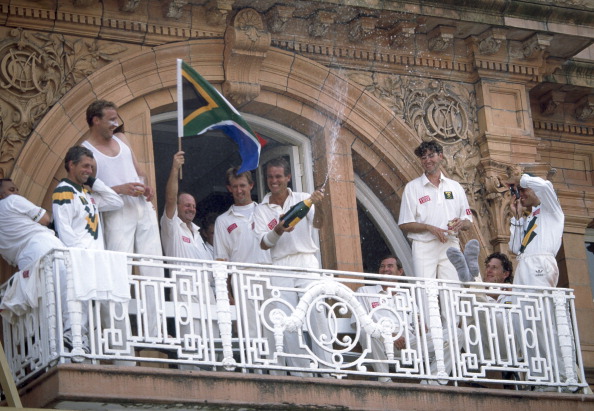South Africa’s first post-isolation tour of England remains, 23 years later, a career if not lifetime highlight of every player who came on it. In many ways, chiefly itinerary, it resembled many of the tours before it.
In 11 weeks the tourists played just five internationals – two Texaco Trophy games in which they were well beaten – and three Test matches which were shared. South Africa won at Lord’s, as they tend to do, held on for a dramatic draw in fading light at Headingley where 39-year-old Peter Kirsten scored his only Test century, and were then blown away by Devon Malcolm at the Oval.
The rest of the time was spent playing an extraordinary 11 First-Class matches against counties, a President’s XI and even a combined minor counties team as well as a variety of other fixtures – a one-day game against the Earl of Carnarvon’s XI was another throwback to a bygone era. There was even a one-day game against Scotland scheduled, but it was rained off.
South Africa won just two First-Class games on that tour – one was at Lord’s and the other was against Nottinghamshire. But they lost only two, as well, at the Oval and a peculiar match against Kent during which disinterest prevailed. The other ten matches were all drawn, often spectacularly boringly.
But nobody cared. It was a full tour of England, in the fullest sense, and it meant the world to the players. Every smattering of die-hard fans was a pleasure to experience – and there were many other experiences besides. Every single member of the squad had spent their entire lives up until three years earlier believing that international cricket would never happen in their lifetimes.
Durham had only been a First-Class county for two years and they provided one of the more memorable and meaningful fixtures. A young Gary Kirsten was ‘waved in’ by coach Mike Procter after reaching 200 in order to give the rest of the batsmen some time in the middle. It was a sign of the naivety of the squad that Kirsten, one of the youngsters, didn’t realise the innings counted as an ‘out’ unless officially declared ‘retired hurt’ or ‘retired ill’. A frantic and late appearance in the scorers’ box was overheard: “No, no, I’m sick. I’ve got a fever, a cough…” The innings was officially declared a ‘not out’ at the end of the match.
A convivial, medieval-themed evening was enjoyed by players and media at Durham Castle, at which a suitably-attired local explained how best to eat soup with only a lump of stale bread and no spoon, as castle staff had to do in the 1400s. He introduced himself as ‘Duncan Suckett’.
Times have changed, some say beyond recognition, but for South Africans the joy and sense of history of playing here will never change. We have a problem with history, of course. Ours is deeply tainted and one way of coping with the legacy of Apartheid is to deny that anything good ever happened while it existed. It is entirely understandable.
The cricketing result is that current players know nothing about the last generation to play before isolation, Barry Richards, Graeme Pollock and Mike Procter etc, never mind those who preceded them. The acceptable face of cricket began in 1991 and the player numbers on shirts and caps reflect that. It hurts, especially for the descendants of those cricketers who took a stand against the regime and fought for equality in sport, like Eddie Barlow and Vince van der Bijl. But the hurt doesn’t compare to that experienced by the many brilliant cricketers who never had a chance of playing for their country before isolation.
England’s performance at Headingley in the first ODI provided a stark reality check for AB de Villiers and his number-one ranked team. It wasn’t as easy as saying, “we had a bad day at the office”. South Africa performed well, no excuses. They were simply, in brutally honest terms, completely outplayed.
They selected their best team for the day and were unable to counter their greatest concern – the relentless depth of their hosts’ batting. Having suffered a dearth of all-rounders for two years, the Proteas now have four but the quality of the assault launched by Moeen Ali at number seven has made them acutely aware that their all-rounders are all number eights – or nines.
Dwaine Pretorius, the one who didn’t play, is the closest to a 50-50 all-rounder they have but, with the selection criteria which applies to South African teams, they cannot play both him and Chris Morris – who is the more explosive, wicket-taking bowler. There is no longer anything ‘unspoken’ or awkward about the selection criteria. The target for every starting XI is six players of colour, two of whom must be Black African.
It is a target for the year, not strictly enforceable for every game, but one which must be reached on average. There are no complaints because there are no doubts that every player on tour is here on merit and has the quality and credentials required.
South Africa, having thrashed Australia 5-0, beaten England, Sri Lanka, India and New Zealand en route to winning their last seven ODI series and 12 of the last 14, are rightly ranked first. So, for England, Wednesday’s thumping at Headingley should count for a great deal.
This piece originally featured in The Cricket Paper, May 26 2017
Subscribe to the digital edition of The Cricket Paper here















